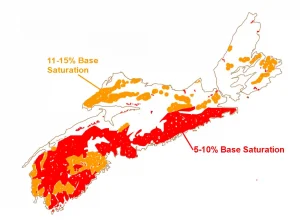
An inconvenient truth: sketch shows prominence of highly acidic, calcium-deficient/high aluminum forest soils in Nova Scotia. Sketch after Keys et al. (2016), Fig 3.
In my view, soil and water acidification is the single most serious threat to biodiversity in NS and to future productivity of our forests and waters. It also has a major impact on carbon sequestration.
Remarkably, these issues are rarely highlighted or discussed in the public domain in Nova Scotia, They involve ‘some chemistry’ which seems to be a strong impediment to broader appreciation of the significance of the issues.
On the flip side, we have some the very best scientific research in this area; we have the tools to address the issue and some practical experience in using them
For an overview, see
– On Salmon and Soils, An Update
Post on nsforestnotes.ca Feb 21, 2023. Soil Scientist Kevin Keys, now retired from NS NRR has led critical research on the acidification of NS forest soils and means of reversing it. Since April 2023, he has been a Project Scientist with the Family Forest Network “overseeing implementation and assessment of multiple research trials showcasing ecological forestry practices on small private woodlands in Nova Scotia”.
– Carbon Run: Healthy Rivers. Healthy Planet. Naturally; also view this insightful piece on Shannon Sterling: Meet Shannon Sterling, environmental scientist (Dal News, Sep 22, 2023)
Shannon Sterling is an associate professor in the Department of Earth and Environmental Sciences at Dalhousie University. Shannon has taken up the mantle from some really good aquatic scientists before her whose research into aquatic acidification in NS was stimulated in large part by the precipitous declines in our salmon populations in the early 1990s. A major advance made by Shannon was the recognition of related impacts on carbon exchanges with the atmosphere. “When she’s not teaching her students about the science behind climate change, she’s leading the charge as Chief Scientific Officer at CarbonRun, the carbon-dioxide removal startup she founded last year. By increasing the alkalinity of rivers, CarbonRun technology captures carbon from the atmosphere while restoring acidified river habitats at the same time.”
Where Ideas Meet Impact: Hydrologist’s research positions her to take a global lead in atmospheric carbon dioxide removal
Andrew Riley for Dal News, April 11, 2024 “While pursuing research aimed to restore Nova Scotia salmon habitats, Dalhousie hydrologist Dr. Shannon Sterling and Dal alum Dr. Edmund Halfyard stumbled into the forefront of carbon dioxide (CO2) removal science and growing market demand to remove the gas from the atmosphere. The discovery led to her current role as founder and chief science officer of CarbonRun, a promising CO2 removal startup attracting investment from global players.”
